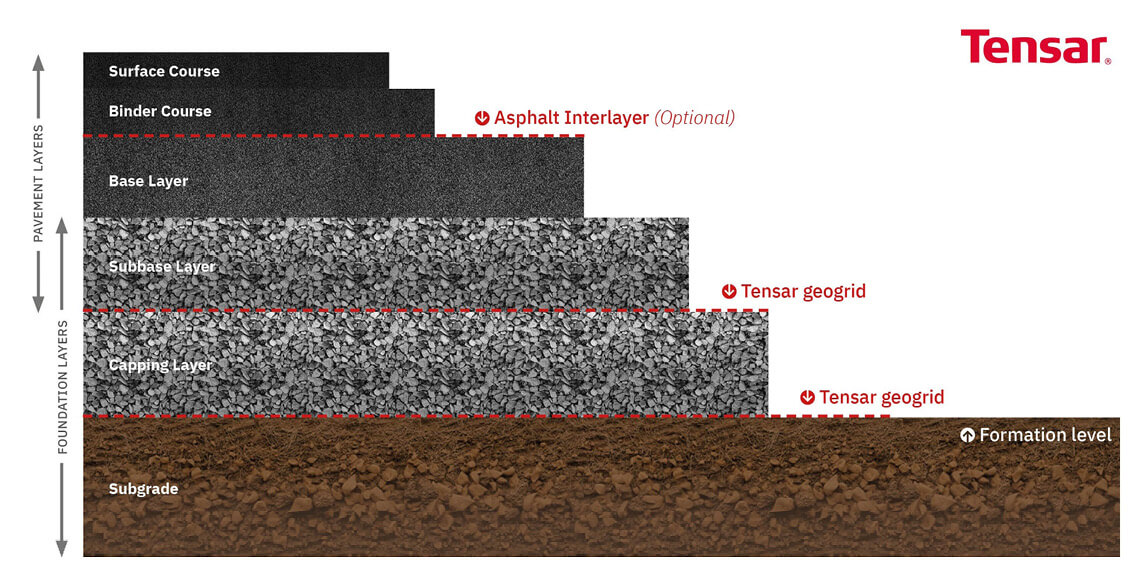Flexible Pavement: Layers, Components, and Advantages
Flexible pavements or roads are areas of asphalt that “bend” or “deflect” due to traffic loads, making them less susceptible to damage and requiring fewer repairs over time. A flexible pavement structure is composed of several layers of different materials, which together enable the road to accommodate this flexing.
In this guide, we’ll discuss:
- What is flexible pavement?
- Where is a flexible pavement used?
- Functions of flexible pavement
- Types of a flexible pavement
- Layers of flexible pavement and what they do
- The advantages of flexible pavement
We’ll also look at a flexible pavement cross section and explain how Tensar geogrids can be used to provide flexible pavement stabilisation - assisting in the construction of a more robust and longer-lasting structure. Use our TensarPave pavement design software to quickly help design engineers visualise, prepare and understand the parameters and requirements of projects prior to construction.
What is a flexible pavement?
Flexible pavement consists of a surface layer of bitumen-bound aggregate (asphalt concrete), several lower layers of appropriate quality aggregate and the subgrade beneath. The layers enable the pavement to “bend”, reducing damage and the need for repairs over time.
Where is flexible pavement used?
Flexible pavement is used in road pavement construction, highways, airport runways, and car parks where traffic loads are moderate to heavy. It is well-suited to areas with varying climates and soil conditions, as it resists cracking and deformation.
Functions of a flexible pavement
Flexible pavements serve three functions, and in order to achieve these effectively, several layers are required:
- The initial (visible) function of flexible pavements is to provide a surface that is safe, smooth and durable enough for the traffic anticipated to be using it, over the design life.
- The second key function is to distribute loads from the vehicle tyres onto a wider area underneath (subgrade – see later) so that the subgrade does not deform under repeated loading.
- Lastly, it is important to protect the lower pavement layers and subgrade from any of the weakening effects of water.
Types of flexible pavement
There are many types of flexible pavement in use currently, the most common of which include:
- Full-depth asphalt pavement: In this type, the entire pavement structure is made from asphalt materials without a separate base or sub-base layer. Hot mix asphalt (HMA) is a paving material used to construct full-depth asphalt pavements. It is often used in areas with heavy traffic, as it provides strong load distribution and is quicker to construct.
- Conventional layered flexible pavement: This type consists of several layers, usually consisting of a base course, a sub-base layer, and an asphalt surface course. Layer interlocking distributes the weight and each layer has a unique strength and material composition.
- Contained rock asphalt mat (CRAM): This kind of flexible pavement is made by sandwiching two layers of asphalt with an aggregate layer. Open-graded or dense aggregate may be utilised.
- Composite pavement: This is a hybrid of flexible and rigid pavement with an asphalt layer over an existing concrete layer. This combination enhances the structural capacity and durability of the pavement, reducing maintenance needs.
Layers of a flexible pavement
The structure of flexible pavement is typically made up of the following layers:
The various layers of a flexible pavement can be divided into two overlapping sections: the pavement section and the foundation section.
The foundation section of a flexible pavement comprises the subgrade and subbase with possibly a capping layer between, whilst the pavement section includes the subbase, the base, the binder course and the surface course layers. Together, these two overlapping sections form the overall structure of flexible pavement.
The foundation section enables the structural road layers to be properly placed and compacted. In addition, the foundation layers of a flexible pavement must support the construction traffic, distributing the load to protect the subgrade from deformation.
A flexible pavement's foundation section may have either a single layer or double layer above the subgrade, comprising either a subbase and capping layer or simply the subbase. The layers must be sufficiently thick to prevent frost damage in the flexible pavement's structural layers. Provided they are thick enough, water is unable to rise up into the base layers where it could freeze and weaken the layers, also known as freeze thaw weathering. .jpg)
Layers of a flexible pavement shown in cross section, divided into two overlapping sections: the pavement section and the foundation section.
The subgrade layer
The deepest element of the foundation section in flexible pavements is the subgrade. The upper surface of the subgrade is known as the formation. If the road surface is to be constructed at or below the original ground level, the formation will be in a cutting, where material has been removed – excavating to the required depth. Alternatively, if the road surface is above the original ground level, the formation will be the top surface of an embankment formed from imported soil. Either way, the formation is usually graded to a cross fall to facilitate the drainage to the side of the pavement.
The subgrade is mostly compacted natural soil, and the design engineer will need to know its strength and condition as it impacts pavement design, often determined through soil testing such as particle size distribution analysis.. Water will affect the post-construction strength, and drainage is therefore essential to maintaining consistent strength.
The capping Layer
Capping materials are typically secondary aggregates or recycled demolition materials. They may also be lime or cement-stabilised soils. The thickness required by the capping or subbase layer in a flexible pavement may be reduced by the inclusion of soil stabilisation geogrids, such as the Tensar geogrid at the base. The geogrid aperture size should be compatible with the different types of aggregate used. For lower-strength subgrade soils, a geotextile separator may also be incorporated to prevent the migration of fines upward into the pavement layers.
Assess the time and cost benefits when using geogrids for your road construction project.
Access our free Tensar+ software
The subbase layer
The subbase layer of a flexible pavement will usually be a higher quality, well-graded aggregate. The grading may be designed to provide a drainage function, carrying water that may ingress the surface to the side of the pavement.
The base layer
The structural layer is often called the base layer, and it is the primary load-spreading layer, which is the backbone of the flexible pavement. The base layer's function is to distribute the traffic-induced stresses at the bottom of the surfacing layers widely and evenly onto the foundation section. It can be formed from either compacted, high-quality unbound aggregate or a bitumen-bound aggregate layer. In some cases, cement-bound aggregate is used for the base layer, though there can be issues with cracking, which require continual maintenance.
The base layer must be designed to perform adequately over the 20-year service life of the flexible pavement, without excessive rutting, deformation or cracking. The inclusion of Tensar stabilisation geogrid in the subbase or unbound base layer can increase the design life for a given thickness of pavement, or enable a reduction in thickness reducing the whole life cost of the pavement.
To explore the cost and time savings Tensar geogrids can deliver, request a free design assessment and discover how Tensar can add lasting value to your next road, pavement, or trafficked area project.
The binder course layer
The binder course is an intermediate, bitumen-bound aggregate layer placed between the base layer and the surfacing of asphalt pavement, sometimes referred to as a levelling course. The binder course's function is to distribute the load from the surfacing into the base course, strengthening the pavement. The thickness of the binder course layer should be bulkier than the surface layer, meeting the requirements of 40mm thickness, however, 50mm thickness is ideal for creating a strong pavement.
The surfacing layer
The surfacing course (layer) is the upper layer of the flexible pavement and provides the smooth, durable, abrasion-resistant characteristics of a good roadway, retaining adequate friction for road safety. It is normally made from bitumen-bound aggregate, which is asphalt concrete. It will be waterproof and prevent ingress of water into the lower pavement layers, which would adversely affect their strength. These layers must be strong enough not to rut under the action of traffic.
The surfacing may be susceptible to cracking due to fatigue or from cracks reflecting upward from cracked base layers. Asphalt Interlayers such as Glasstex or Tensar ARG-GN reinforcement can be incorporated at the base of the surfacing or maintenance overlay to delay cracking.
The advantages of flexible pavement
Thanks to the various layers of flexible pavement, it offers the following advantages for cost-effective and durable pavement design and value-driven infrastructure solutions:
- With flexible pavement, the subgrade beneath is less likely to deform than with rigid pavement.
- Repairs are easy and inexpensive with flexible pavement.
- The installation process does not require joints, and materials are cheaper.
- Its short curation time (typically less than 24 hours) makes for quick installations, reducing traffic disruption.
- Black ice is less likely to form on the surface of flexible pavement.
- Water is unable to rise up through the lower layers, preventing the pavement from becoming weakened.
To learn more about the differences between flexible and rigid pavements, see our guide to types of pavement and road construction methods.
Benefits of flexible pavement over rigid pavement
Flexible pavements offer several advantages compared to rigid pavements, making them suitable for a variety of road and infrastructure projects:
- Lower initial cost: This is due to the use of relatively inexpensive materials, such as asphalt, which reduces upfront expenses.
- Easier to install without the need for joints: This helps streamline construction and avoids complications associated with concrete expansion and contraction joints needed in rigid pavements.
- Ease of repair: Flexible pavements can be quickly patched or resurfaced with minimal effort, which is ideal for addressing damage caused by frost heave, settlement, or other ground movements.
- Less prone to ice glaze formation: Flexible pavement reduces winter maintenance needs and is better suited for adapting to minor soil shifts, which can be advantageous in areas with fluctuating soil or weather conditions.
To learn more about the differences between flexible and rigid pavements, see our guide to types of pavement and road construction methods.
Next steps
This guide has explained what flexible pavement is, its functions, the layers of flexible pavement, and the advantages it offers. If you’ve found this post useful, you may also want to read some of our other articles:
- What is rutting in roads?
- Types of road cracks and how to avoid them
- Geogrids in temporary access roads
To find out more about how Tensar products support road design and construction processes, visit our pages on geogrids and other geosynthetic construction solutions.
Tensar provides a range of reinforcement solutions that can support your asphalt pavement design work. Get in touch with our team today for a free design assessment.
Request Design Assessment



.jpg?width=400&height=400&ext=.jpg)